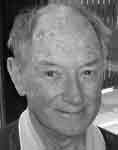JARS v64n3 - Regional Musings from Hawai'i and Australia
Regional Musings from Hawai'i and Australia
Vireya Gladiators
Bettye Wakabayashi
Mountain View, Hawai'i
Reprinted from the May 2010 Viva Vireya newsletter of the Hawai'i ChapterI would like to encourage new members timid about growing vireyas by telling you a tale about these two plants and the marvelous survival stamina of the vireya! I like to take my free trusses home from the meeting each month, put them in a pretty bottle and enjoy the trusses as long as they bloom. When the blossom dies, I take each petal off and leave the truss in the bottle in the window to admire, and wait until I have time to plant it in the ground. I often don't seem to ever get around to this for months!
In September 2009, I went to the Mainland (USA) for a two month visit. My husband George remained home to feed the cat, water the plants, and play golf! I felt that leaving him with nine trusses to water was asking a little too much (nine trusses adds up to four months of collecting trusses at each Club meeting!). Therefore, I decided to stick them in the ground and hope for the best! I got a cup (.25 l) of potting soil, 1/2 (.12 l) cup of Vermiculite, dug a hole in the cinder, packed everything in the hole, labeled the truss, and left town! That was in September, and considering that I had been collected these trusses since May 2009, that may make some of them almost a year old by May 2010! These pretty little plants are now five months in the ground - and without a bit of help from us! Because of the current drought, we cannot waste water on plants - they make it on their own, or not! They are on the south side of our house, in full sun, all day, and under no trees to give any shade! Talk about survivors! If you have any doubts about your ability to grow vireyas, please put them to rest - these darling plants are proof of their remarkable ability to survive - in spite of us!

Bettye Wakabayashi is a member of the Hawai'i ARS Chapter.Vireya Import Challenges into Australia
Simon Begg
Olinda, Victoria, Australia
Reprinted from the Vireya Vine, Issue 89, February 2010At one time The Vireya Vine received many letters from Australia. Fifty years ago Australia was, mostly, the very first stop a new Vireya species made after it was dug up, cut or its seed collected in its place of origin. This was often the case when the collector was not even from Australia. John Rouse, Don Stanton, Ralph Sangster, Tom Lelliott, Graham Snell, Clyde Smith, Bob Withers, Lyn Craven, Brian Clancy, Jack O'Shannassy and other Australian Rhododendron Society members whose names presently escape me, not only grew on and distributed the species but produced hybrids of lasting value. Lyn and Brian are the only ones of this group still alive with Lyn the only one both active and in communication with the Society.
New members have joined and gained expertise but not in the numbers of the past. The most notable new expert is Andrew Rouse, son of John. I believe Andrew has, now, the most complete vireya species collection in Australia. Others include Barry Davidson, Murray McAllister, Bill Taylor, Neil Puddey, Lesley Eaton, and, in respect of hybrids, Kaye Hagan. There are certainly far fewer, if any, current primary species collectors from Australia.
These days, and for many years past, most new species have gone elsewhere first before arriving in Australia. New Zealand, Scotland, the USA and, latterly, France have provided the primary collectors. In very recent times Australian and New Zealand quarantine restrictions have inhibited both primary and secondary collection of species and all but abolished import of hybrids.
Victoria, the Australian State where I live, went through very dark days before I became an active Society member in the late 1990s. Many of the species that were once in Australia could not, with certainty, be located - certainly not at National Rhododendron Garden, Olinda, that was once their Australian home. Murray McAllister with the help of Bill Taylor set out to re-establish and, if possible, grow, the Victorian Society and NRG vireya collections. They obtained many species from Lyn Craven in Canberra and from Andrew Rouse. Murray and Bill went to New Zealand in 2003 and collected cuttings from many New Zealand collections. I think this was the last time Vireya cuttings, rather than vireya species seed, were imported into Australia. Subsequently, before the full force of new import restrictions came into effect, a number of species were imported as seed, some from New Zealand, much from Edinburgh and some from the RHS, the Rhododendron Species Foundation and elsewhere. Australia's (and New Zealand's) import barriers now work on the basis that plant material sought to be imported must, specifically, be permitted on a "permitted" list - otherwise it is prohibited without a permit. Previously material was permitted unless specifically prohibited. The recognition of Sudden Oak death (SOD) changed everything. There are two specific form of phytophthora that cause SOD problems, P. kernoviae and P. ramorum , that are not present, yet, in Australia, but P. cinnamomi (causes cinnamon root rot affecting many woody ornamentals including azaleas and rhododendrons) is present, as well as elsewhere. The initial vireya permitted list contained only a handful of species. After representations by Bill Taylor, this permitted list was expanded to include all species his research showed already to be in Australia. To get a permit for a new species (a species not on this expanded list), it was necessary to prove to Australian Quarantine Inspection Service's [AQIS] satisfaction that the species was already in Australia or, far more difficult, to prove to Biosecurity Australia (a different Government body) that the species' weed potential scored below a certain figure on a weediness scale. If it scored above that it was either prohibited outright or prohibited "pending further, detailed, examination."
One trial species was selected and a permit sought for its importation. This evoked the "further detailed examination" response. An impasse, since no Society member had the resources, or knowledge, to make a meaningful detailed weediness submission to get a positive response in a "detailed examination." But all knew that getting vireya species to grow was a major achievement and, intuitively, that their weed potential was, really, zero.
My contribution to this embroglio was to treat the impasse just as I would an office problem in my ordinary work. First I listed all the known vireya species not permitted. Straight out of Dr George Argent's book " Rhododendrons of subgenus vireya ". I did the same for non-Vireyas using Peter and Kenneth Cox's The Encyclopedia of Rhododendron Species . Then I requisitioned members about the "Already in Australia" list for both vireyas and other rhododendrons and found a considerable number of species in both categories that should be, but were not, on the permitted list. I cross-referenced every species to an authoritative text, sometimes more than one. I picked up typos in the permitted list.
Then I asked for Biosecurity help! I pointed out that one key element in "weediness" potential was comparison of the climate in the species' place of origin with all Australia's climates. This required a computer program (for which a very substantial license fee had to be paid) and, importantly, the skills to run it. I said, as was certainly true, that I lacked the requisite skills. I hinted at a lack of resources. Could Biosecurity do this for me? I produced emails showing relevant experts did not believe rhododendrons had weed potential save for certain hybrids of R. ponticum . The Biosecurity response? All the "Already in Australia" species on my new list would, on a next reprint of the database [ICON], be added to the permitted list. Would I (then) prioritize which species needing weediness assessment I wished to be dealt with first? I did. Initially I worked on a common source, thinking that would make the climate program work better. I picked a specific part of Indonesian New Guinea, knowing George Argent was going there, and a list of Vireya species George hoped to collect there. In short order, a winner. Then I picked the Edinburgh vireya species not already in Australia thinking they were the most possible to get seed from. More wins, but by now the process slowed down from sheer volume and, importantly, both my having other commitments and Biosecurity having other important work. I must remind myself to go back to the task before both I and Biosecurity forget where we were!
The task thus proves not to be impossible. It is persistence that is required. I hope it is translatable to New Zealand. There, I understand, R. ponticum and the species that produce the weedy hybrids with it have been prohibited, notwithstanding, I assume, as they are all in New Zealand. That has not happened in Australia.
As I walked around my wife Marcia's and my garden today, in beautiful sunshine, I thought of all the cottage plants Marcia has lawfully imported over the years from the RHS. Many, placed in our soil and conditions, think paradise has come and spread as if to colonise the Earth. We do pull a lot of these out! I have yet to meet a vireya that does more than provide a layered clone or two. None, yet, has germinated from seed without my seeking it.

Simon Begg is the editor of The Rhododendron, the official journal of the Australian Rhododendron Society.

